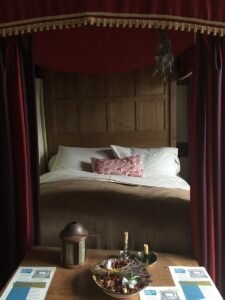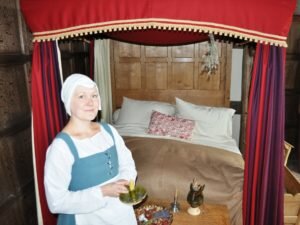
One of the motivations for the How We Used to Sleep project was the ongoing ‘global sleep crisis’ we are currently experiencing. In our 24/7, always connected, constantly illuminated western culture, many of us are guilty of neglecting sleep or of not devoting much thought to how we might sleep better. We have heard the voices of neuroscientists, governmental agencies and medical professionals, often with mixed results, but what can historians add to this conversation? What can early modern people teach us about how to sleep well?
Early modern sleep-management practices look remarkably similar to contemporary advice. The following tips blend early modern sleep advice with the tips developed by one of our project partners, The Children’s Sleep Charity, who are on a mission to improve the sleeping lives of the UK’s children and young people.
1. Routine:
Sleep advice for children recommends rising from and retiring to bed at the same time EVERY day. This familiar routine helps to regulate circadian rhythms to make sure they get the right amount of sleep.
Early modern people get top marks for this – they went to bed consistently as it went dark and woke at daybreak. They would stick to these bedtime routines as much as possible.
The Tudors took their cues about bedtime from changes in natural light throughout the year. Bedtimes were regulated by routine habits such as ‘shutting in’, when the doors and windows of households were locked or secured to keep out external intruders. This was followed by ‘candlelighting’, a quiet period of an hour or so before bed in which to wind down and relax, before bedtime. Certainty and discipline were important.
It’s a good idea to give children a warning that bedtime is approaching, stipulating a time when the bedtime routine will begin. Perhaps use a timetable somewhere to show them that this is what happens every night and that this routine doesn’t shift, drift or slip.
2. Environment:
Modern sleep advice warns about the dangers of exposure to ‘blue light’ in the hour before sleep. Blue light, emitted by computers, TVs, and other devices can interfere with the body’s production of melatonin – a hormone that eases sleep’s onset. These devices should be shut down to improve the chances of sleeping well.
Early modern people didn’t have blue light but they did have their hour of ‘candlelighting’ when they stopped the hard graft of the day and relaxed before bed. Light was available from candles, oil lamps or rushlights. The use of candle-light, subtle night-lights and dimmer switches can help us to replicate some of these practices today.
Calming music before bed can help your child to get into the right frame of mind for sleep. Subtle sounds such as soothing music, nature sounds or white noise are believed to be particularly helpful for helping children to wind down.

Early modern households were rarely quiet at night-time. Floorboards creaked and groaned as timber houses settled at the end of the day. The sound of trusted family members, servants and companions sleeping in close proximity, bed creaks, quiet prayer or even, in towns and cities, the cries of the watchmen calling out the time on the hour, created a familiar soundscape that likely offered reassurance on a nightly basis.
You can also pay attention to the visual dimensions of your child’s bedroom. Do the colours create a feeling of calmness? Are there too many posters on the walls that might over-stimulate your child? Where are the toys stored? Early modern people paid careful attention to their sleeping environments. They favoured familiar and personalised bedding textiles that replicated the same sensations each night. Textiles could be used to create a feeling of enclosure and security. Servants often used blankets or strips of linen to create partitions between bedsteads in shared sleeping spaces.
Try not to banish a child to their bedroom for a disciplinary ‘time out’ as they may start to associate this space with feelings of anger or guilt. Instead, it is helpful for a child to see their bedroom as a sanctuary. Early modern people appear to have regarded their sleeping spaces in much the same way. They used religious images and even protective wall markings and charms to ward off evil spirits around their beds to create a space in which they felt positive and secure .
3. Meaningful Objects:
Meaningful objects such as a teddy or blanket can help comfort and settle your child at bedtime, and in the middle of the night, should they wake up unexpectedly. Early modern people drew comfort from familiar bedside objects. They cocooned themselves in familiar bedding textiles to provide a feeling of protection. Pillows, blankets, quilts and curtains were often embroidered with relaxing natural images of flowers and animals, or with religious symbols that were believed to invoke spiritual protection during the night. Textiles often included family names, dates of births and weddings, which may have conjured comforting thoughts of loved ones, just as our family photos on the bedside table do today. It certainly helps to keep the sleeping environment constant, so that a child experiences the same conditions in the middle of the night to the ones they fell asleep in. Needing a grown-up with them to help them go to sleep or a light that is too bright will cause a child to panic if these things are suddenly missing should they wake up.
4. Darkness and Light:

It is a good idea to invest in a black-out blind. This will reduce the infiltration of street lights into your child’s bedroom, optimise darkness and help your child to fall asleep and to stay asleep. Some sleep experts insist that darkness is important for the body during the night and that light sources can be detrimental to health. If a completely dark room is too much for a sensitive or visually impaired child, a low level night-light can help.
Early modern people were exposed to far fewer sources of artificial light than we are today. Street lights only emerged in urban centres from the late 17th century onwards, and they were not very bright, thus reducing any potential sleep disruption. People taking part in experiments where they have been deprived of electric lightning will often revert to sleeping in two blocks during the night. We know that many early modern people slept like this, in two separate cycles, which they called their ‘first sleep’ and ‘second sleep’.
5. Chats, Stories and Activities:
Doing activities that encourage the use of fine motor skills are great before bed as they relax the body and mind. Jigsaws, colouring, simple craft activities such as sewing or threading beads are all good examples. During the evening ‘candlelighting’ hour, the activities people focussed on included knitting, sewing, reading, prayer, chatting or catching up on quiet, therapeutic jobs such as carding wool or husking corn. These activities may well have had a calming effect that helped to ease sleep’s onset.
We know that a bedtime story is a perfect way to end the day. Providing relaxation and escapism. It can help to clear the mind of any worries a child may have. This part of the day is a good time to have a chat about things and give your child your full attention. This provides a sense of security, love and protection as well as ensuring that your child has a chance to get things off their chest and empty their minds before drifting off to sleep.
Early modern people were also very keen to get things off their chests before bed. Often this would be through having chats during candlelighting or with sleeping companions once in bed. Furthermore, evening prayer before bed was another means of putting worries to one side through seeking forgiveness, reassurance and solace from God.
All of this goes to show that people in the past knew their stuff. They knew the importance of sleep to physical and mental health and they knew how to optimise their rest. If we want to address today’s sleep ‘crisis’, we could learn some valuable lessons from sleep’s history in the early modern world.